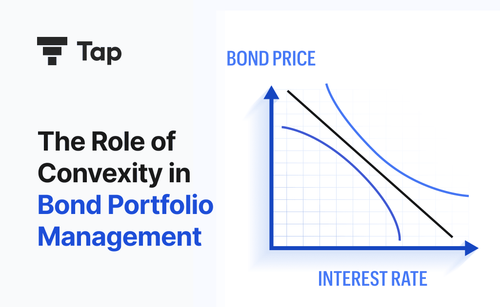The Role of Convexity in Bond Portfolio Management
07 May 2025 · Sachin Gadekar
How Convexity Helps You Manage Interest Rate Risk and Maximize Bond Portfolio Returns.

The Role of Convexity in Bond Portfolio Management
How This Advanced Metric Enhances Risk Management and Return Optimization
In the world of fixed-income investing, understanding price sensitivity to interest rate changes is crucial. While duration is often the go-to metric for gauging interest rate risk, it doesn’t tell the full story. This is where convexity comes into play—an essential yet often overlooked concept in bond portfolio management.
Whether you're a retail investor or a portfolio manager, factoring in convexity can lead to more accurate risk assessment and better investment decisions. This article explores the role of convexity in bond investing, why it matters, and how platforms like TapBonds.com help you navigate such advanced concepts with ease.
📘 What is Convexity?
Convexity is a measure of the curvature in the relationship between bond prices and interest rates. In simpler terms, while duration estimates how much a bond’s price will change with a 1% change in interest rates, convexity shows how duration itself changes as rates shift.
🔍 Formula (Approximate Convexity):
Convexity= 1/ P . d²P / dr²
Where:
P = bond price
r = interest rate
Higher convexity means a bond is less sensitive to interest rate risk in a nonlinear fashion, offering greater price stability in volatile markets.
🎯 Why Convexity Matters in Bond Portfolio Management
1. Improves Interest Rate Risk Estimation
Duration provides a linear estimate of interest rate sensitivity, which works well for small changes. But markets are rarely linear. Convexity accounts for nonlinear price movements, giving a more accurate picture of potential gains or losses.
📌 Expert Take:
“Convexity is the secret sauce of bond investing. It helps investors avoid surprises during volatile rate shifts.” — TapBonds Fixed-Income Research
2. Helps in Identifying Better Bonds
Two bonds may have similar durations but different convexities. The one with higher convexity tends to:
Appreciate more when yields fall
Lose less when yields rise
This makes convexity an important metric in selecting bonds that offer asymmetrical payoff potential.
3. Enhances Portfolio Immunization
In portfolio management, immunization is the strategy of matching asset and liability durations to neutralize interest rate risk. Including convexity in this analysis ensures that even with non-parallel shifts in the yield curve, the portfolio remains protected.
4. Better Hedging Strategies
Convexity plays a key role in designing hedging strategies using derivatives, bond futures, or swaps. For example, portfolio managers often match both duration and convexity of assets and liabilities to minimize risk in uncertain rate environments.
5. Valuable During Market Volatility
In times of high market volatility or when central banks are actively adjusting policy rates, bonds with higher convexity are more attractive. They provide better upside and limited downside, preserving capital more effectively.
🧮 Convexity in Action: A Simple Example
Let’s say you hold two 10-year bonds with the same yield and duration, but different convexity:
Bond A: Duration = 5, Convexity = 90
Bond B: Duration = 5, Convexity = 120
If interest rates fall by 1%, both will gain, but Bond B will gain more due to higher convexity. This extra price gain is critical for portfolio managers seeking alpha in falling rate environments.
🔧 How to Manage Convexity in a Portfolio
Use Barbell Strategies: Combine short-term and long-term bonds to achieve higher convexity.
Monitor Yield Curve Changes: Non-parallel shifts impact convexity-adjusted returns.
Optimize via Bond Funds or Platforms: Platforms like TapBonds.com help investors screen for high-convexity bonds efficiently.
Regular Portfolio Rebalancing: Reassess convexity periodically to align with your risk tolerance and rate outlook.
🙋 Frequently Asked Questions (FAQs)
1. Is convexity always good for a bond portfolio?
Not necessarily. While higher convexity offers better protection against interest rate changes, it often comes at a cost—lower yield or premium pricing.
2. How can I calculate convexity manually?
Manual calculation involves second-order derivatives and cash flow timing. Most investors use platforms like TapBonds for automatic convexity data.
3. Can short-term bonds have high convexity?
Typically, no. Long-term bonds or those with embedded options (like callable bonds) show higher convexity.
4. What’s the difference between positive and negative convexity?
Positive convexity: Price rises more than it falls for equal interest rate changes.
Negative convexity: Often seen in callable bonds—price gain is limited as rates drop due to early redemption risk.
5. Does convexity matter for corporate bonds?
Yes. For corporate bond investors, convexity helps evaluate how sensitive the bond is to rate changes, especially when paired with credit risk.
🧭 Conclusion: Make Convexity Work for You
Convexity isn't just an academic concept—it's a powerful tool in managing bond portfolios. It enhances duration-based analysis, informs better investment decisions, and helps navigate volatile interest rate environments.
For retail investors and professionals alike, understanding convexity is essential to optimize returns while managing risk. And with platforms like TapBonds.com, integrating this advanced metric into your portfolio strategy is easier than ever.